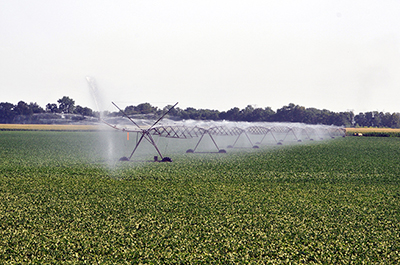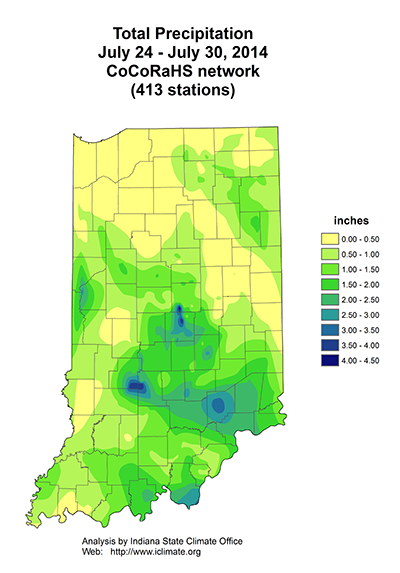USDA-NIFA Extension IPM Grant
Pest & Crop Newsletter, Entomology Extension, Purdue University
- New Webcasts Save Time, Money, and Pesticide During Soybean Aphid Season
- 2014 Corn Earworm Trap Report
- Western Bean Cutworm Adult Pheromone Trap Report
New Webcasts Save Time, Money, and Pesticide During Soybean Aphid Season – (Phil Bogdan, Plant Management Network) -
Soybean aphids can cause significant damage and lower yield potential on their namesake crop. It’s no surprise, then, that soybean farmers will spray for peace of mind and ‘insurance’ when even a few of these bugs are sighted.
But growers and their consultants can save on time, money, and pesticides by following economic thresholds and using key biological controls.
This is the idea behind some key applied research conducted through a North Central Soybean and Research Program (NCSRP) grant led by Kelley Tilmon, Associate Professor and Soybean Extension Entomologist at South Dakota State University.
The key findings and recommendations from this NCSRP project are now available through three easy-to-follow, open-access webcasts produced by the Plant Management Network (PMN), a nonprofit publisher of crop management information.
These webcasts are targeted at growers, consultants, and other practitioners in the upper Midwest, where soybean aphids are often an issue. They are available 24/7 and viewable on PC, Mac, and mobile devices. They include…
“Host Plant Resistance for Soybean Aphid <http://www.plantmanagementnetwork.org/edcenter/seminars/soybean/HostPlantResistance/> ” by Dr. Erin Hodges, Associate Professor and Extension Entomologist at Iowa State University. Through this webcast, users can learn about host plant resistance for soybean aphid, as well as the benefits of using host plant resistance to reduce aphid numbers and protect soybean yields.
“Soybean Aphid Management Using Neonicotinoid-Treated Seed <http://www.plantmanagementnetwork.org/edcenter/seminars/soybean/NeonicotinoidTreatedSeed/> ” by Dr. Christian Krupke, Associate Professor and Extension Field Crops Entomologist at Purdue University. This webcast helps practitioners assess the relative value of seed treatments in soybean aphid management. Krupke covers many aspects, including the duration of seed treatments’ effectiveness, their effects on non-target beneficial pests, yield data, and comparisons to the standard IPM approaches of monitoring and treatment.
“Update on Soybean Aphid Biological Control <http://www.plantmanagementnetwork.org/edcenter/seminars/soybean/BiologicalControl/> ” by Dr. Thelma Heidel-Baker, Postdoctoral Research Associate and Extension Coordinator at Iowa State University. This webcast covers the different biological control options for soybean aphid management. It also offers details on the beneficial insects that provide this control. Heidel-Baker also informs viewers about current and ongoing research projects to improve the use of biological control for this pest.
All three webcasts are permanently open access and can be found in the ‘Grant Outreach Webcasts’ section of ‘Focus on Soybean’, PMN’s webcast resource, located at <http://www.plantmanagementnetwork.org/fos> .
‘Focus on Soybean’ is a publication of the Plant Management Network. To get the most out of this and other Plant Management Network resources, please sign up for PMN’s free electronic newsletter, PMN Update <http://www.plantmanagementnetwork.org/update/current/> .
The Plant Management Network <http://www.plantmanagementnetwork.org/> is a nonprofit online publisher whose mission is to enhance the health, management, and production of agricultural and horticultural crops. It achieves this mission through applied, science-based resources, like Focus on Soybean.
To achieve this mission, PMN partners with the United Soybean Board and more than 80 other organizations, including universities, nonprofits, and agribusinesses.
Links Embedded in Text
Host Plant Resistance for Soybean Aphid -
<http://www.plantmanagementnetwork.org/edcenter/seminars/soybean/HostPlantResistance>
Soybean Aphid Management Using Neonicotinoid-Treated Seed - <http://www.plantmanagementnetwork.org/edcenter/seminars/soybean/NeonicotinoidTreatedSeed>
Update on Soybean Aphid Biological Control - <http://www.plantmanagementnetwork.org/edcenter/seminars/soybean/BiologicalControl/>
![]()
Click here to see the 2014 Corn Earworm Trap Report
![]()
Western Bean Cutworm Adult Pheromone Trap Report
![]()
Purdue Weed Scientist: Late-Season Herbicide Applications May be Ineffective - (Emma Hopkins, Purdue/Ohio State Ag Answers) -
For farmers seeing weeds in their crop fields this late in the growing season, hand-rouging and pulling them by hand may be the best way to remove them, more so than using a herbicide, a Purdue Extension weed scientist says.
“The majority of weeds in corn and soybean fields are much higher than the ideal 4-8-inch height, and herbicide applications are only going to provide marginal control at best,” said Travis Legleiter, Purdue Extension weed scientist.
The most common weeds which may not be under control at this time in the season are Palmer amaranth, common waterhemp, giant ragweed and marestail. If herbicides are repeatedly applied to these larger, full-grown weeds, the offspring are more likely to be herbicide-resistant, Legleiter said.
“Although it is human instinct to try and spray something and do something about the tall, ugly weeds in our fields, we may be better off not spraying and not selecting for resistant biotypes,” said Legleiter.
Another risk that comes with spraying herbicides late with residual activity specifically is the possibility of the herbicide carrying over into the winter and spring, which can be potentially damaging to those crops.
“Hand-rouging and hand-pulling may be our only options at this point and the most effective, even though it will be the most time- and labor-intensive option,” Legleiter said.
![]()
Answers to Common Questions about Irrigating Soybeans – (Mike Staton and Lyndon Kelley, MSU Extension) -
This article will help soybean producers make profitable irrigation decisions.
I have not applied any irrigation water to my soybeans. Will I see an economic return by irrigating them at this point in the season?
Yes, especially if the plants are healthy and irrigation can begin at pod initiation. In general, the most important time to irrigate soybeans is from R3 (beginning pod, one pod 3/16 inch long on one of the upper four nodes on the main stem having unrolled leaves) through R6 (full seed, one pod containing green seed that fills the pod cavity on one of the upper four nodes on the main stem having unrolled leaves). Water applied at R3 to R5 encourages flower and pod retention. This increases yield potential by increasing the number of seeds per acre. Irrigation water applied after R5 (one pod with1/8 inch long seeds on one of the upper four nodes on the main stem with unrolled leaves) is also beneficial as it improves yields by increasing seed size. In fact, if soybeans can be watered only one time during the growing season, it should be at R5.
I began irrigating my soybeans in June to get them through the drought. Can I stop watering them now that we have received some rain?
You may be able to delay irrigation water applications due to recent rain but plan to apply irrigation water as necessary through seed fill (R6). Failure to continue irrigation may cause more stress on the crop than if no irrigation water had been applied. This is because soybean plants are able to adjust to soil moisture conditions by changing pod number and seed size. Plants may produce fewer and smaller seeds if irrigation is discontinued. The earlier irrigation applications may have also reduced rooting depth. Monitor moisture levels in the top two feet of soil closely and maintain the moisture level above 60% of the available water holding capacity throughout R6.
When can I stop irrigating soybeans without sacrificing yield?
Research from the University of Missouri showed that terminating irrigation too soon can cause yield losses of ¾ of a bushel per acre per day on a sandy soil. The Missouri researchers made the last application around September 20th which was well into the R7 growth stage. However, most universities recommend timing the final irrigation run so that the soil moisture level is near 60% of the available water holding capacity at the beginning of the R7 growth stage.
Precise timing of all irrigation runs, including the final run, requires a working knowledge of basic irrigation scheduling concepts such as the amount of water required for soybeans at various growth stages to reach maturity, available soil water capacity, allowable water depletions, soybean growth stages, effective rooting depth and estimating soil moisture status. Lyndon Kelley and Steve Miller have compiled a list of Irrigation Scheduling Tools that explain and utilize these concepts.
This article was produced by the SMaRT project (Soybean Management and Research Technology). The SMaRT project was developed to help Michigan producers increase soybean yields and farm profitability. SMaRT is a partnership between MSU Extension and the Michigan Soybean Checkoff program.
![]()
Now is the Time for Irrigation – (Lyndon Kelley, MSU Extension/Purdue Extension) -
If you have irrigation, now is the time to use it. Corn maximum water use weeks are nearing the end as fields enter the blister stage. Soybeans have the greatest potential yield benefit at R-3. Most years these time periods do not overlap for very long, but this year some producers may be challenged to meet the needs of both crop if irrigation system capacity are stretched thin (below one inch / 4 days). This could be a real challenge but the cool weather has kept water use by both crops near record lows for the crop stage.
If you are using a checkbook scheduling system, corn will typically remove 0.19” to 0.24”per day the week silk and the through the weeks blister, for typical summer day time temperatures. Last weeks cool temperatures resulted in week long water removal for corn of only 1.05” to 1.25” across Indiana. Soybean removal are about the same.
Attached is a simple checkbook style paper system. It uses potential ET. from an ET. Gage or weather station like the PAC stations: <https://climate.agry.purdue.edu/climate/data_archive_v3.asp?rdatatype=pd>.
Now begins the time to irrigate Soybeans, they have the greatest potential yield benefit at R-3 and the following two weeks , Soybeans will respond well to irrigation if available soil moisture falls below 60% any time from R-3 through seed fill.
Contact me if you have an irrigation related topic I can address.
![]()






